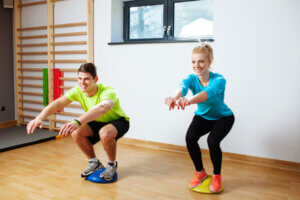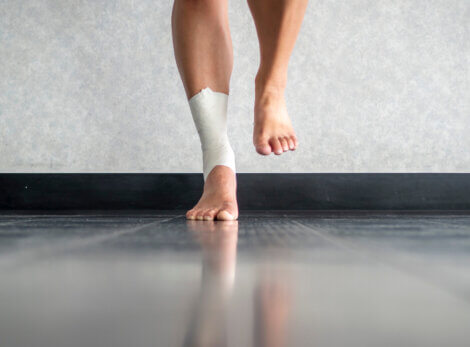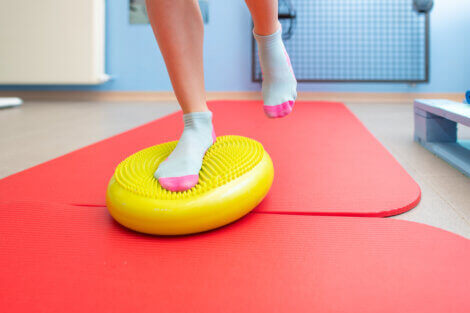Proprioception Exercises to Avoid Injuries

Proprioception is the brain’s ability to know the exact position that the parts of the body have at all times. It’s about being aware of joint movement, speed, and detecting movement force. In this article, we’ll explain some proprioception exercises you can use to improve this skill.
First, let’s explain briefly how the proprioceptive system works. The brain and spinal cord are constantly receiving information from the tension receptors that we have in different parts of the body (in the ligaments, tendons, and muscles).
These receptors continuously send signals to the central nervous system and report on the exact position they’re in at all times. For example, when a muscle stretches or contracts, they send this information to the CNS.
If the receptors are in a situation which they interpret to be dangerous, such as excessive tension or muscle stretching that’s no longer adequate, the brain will send a response with a certain command to make the necessary adjustments. The goal here is to avoid the perceived risk that can lead to injury.
The components of the proprioceptive system
Let’s look at the various components that allow the body to carry out these functions:
Muscle spindles
Muscle spindles are proprioceptive sensory receptors located within the muscle structure. They respond to a stretching stimulus. These sensory receptors are responsible for measuring the length of the muscle, the level of mechanical stimulation, and the speed in which the stretch happens.
Their main function is the inhibition of the antagonistic muscles. In the event that there’s a rapid movement that involves an excessive increase in the length of the muscle, the brain sends the order to activate the myotactic reflex; this reflex generates a response by contracting the muscle when it experiences abrupt or excessive stretching in order to avoid an injury.

Golgi tendon organs
These are the sensory receptors located in the tendons. They’re responsible for measuring the tension developed by the muscle. Golgi tendon organs inform the cerebral cortex of the level of tension in the muscles.
The GTOs send a neurological impulse that activates the reverse myotactic reflex. When a muscle exceeds the tension limit, this reflex serves as a defense mechanism to prevent muscle damage, such as a tear or loss of the tendon insertion.
Joint capsuloligamentous receptors
We can find them in the joint capsule and ligaments. These types of receptors inform the cerebral cortex about the position and movement of the joint.
Vestibular proprioceptors
They’re located in the inner ear and report on the position of the head and its movements. These proprioceptors have a close relationship with a sense of balance.
Proprioception exercises and injury prevention
Through proprioceptive training, the athlete can learn to take full advantage of this mechanism. Reflexes (stretching or myotatic) that can appear in an unexpected situation, such as an ankle sprain, can manifest correctly (helping the body to recover its joint position) or incorrectly (a more severe sprain).
You can use proprioceptive training to eliminate basic incorrect reflexes and optimize your body’s response to avoid an injury.
When we suffer a joint injury, the proprioceptive system deteriorates and there’s a deficit of information that reaches the CNS. That’s why it’s harder to perceive and be aware of the position and movements of the affected structures after an injury.
In turn, this will make it harder for the body to send an adequate response, and it’ll be more prone to relapse. For this reason, it’s essential to restore this altered neurological function by re-educating the movement after an injury.

What kind of proprioception exercises can you do?
You can train the proprioceptive system through specific exercises that lead to improved strength, coordination, balance, and reaction time in certain situations. These exercises also help to compensate for the loss of sensations caused after a joint injury and to avoid the risk of it happening again.
There are countless exercises you can use to work on your proprioception. However, the exercises you choose will be different depending on whether you’re a professional athlete, an amateur athlete, or unfamiliar with regular physical exercise.
Proprioception exercises
Below you’ll find suggestions for exercises that’ll help to improve the proprioception sense for your lower body. It’s important to note that the exercises can serve as a progression guide for a healthy individual.
This means that you can use them as a reference, but not as a guideline; the characteristics of each individual person must always be taken into account before designing an exercise routine.
To get started, you can perform several movement variations in which you maintain your balance on one foot:
- Maintain your balance for a few seconds without putting your foot down.
- Pass a ball from one hand to the other.
- Combine passing the ball with bouncing it on the floor.
- Bounce the ball on one side and pick it up with the hand on the opposite side.
- Pass the ball from one hand to the other, then throw the ball against a wall with one hand and catch it with the opposite hand.
- Bend your hips and knee (in other words, do a one-leg squat).
- Pass the ball behind your support leg and over the leg that’s not on the floor.

Dynamic proprioception exercises
- Move forward and perform a frontal jump while landing on just one foot. Try to maintain the position for a few seconds with proper joint alignment.
- Slide sideways and use only one foot to stop yourself. Pay special attention to your knee-ankle alignment.
- Jog in a diagonal line and stop from time to time while standing on one foot.
- Repeat the previous exercises, but this time try to catch a ball whenever you stop on one foot.
- Combine side, frontal and diagonal movements along with standing on one foot when you stop.
- Try to throw and catch a ball while performing the previous exercise.
Working on your proprioception is worth it
Proprioception exercises can be a great tool to decrease the risk of injuries. However, you have to remember that there are other factors that you can’t control. The possibility of an injury will always be there.
Lastly, it’s worth mentioning that unstable platforms can provide other types of stimulus and more exercise variety, but they aren’t essential either. However, if you do own a balance trainer, don’t hesitate to use it.
Proprioception is the brain’s ability to know the exact position that the parts of the body have at all times. It’s about being aware of joint movement, speed, and detecting movement force. In this article, we’ll explain some proprioception exercises you can use to improve this skill.
First, let’s explain briefly how the proprioceptive system works. The brain and spinal cord are constantly receiving information from the tension receptors that we have in different parts of the body (in the ligaments, tendons, and muscles).
These receptors continuously send signals to the central nervous system and report on the exact position they’re in at all times. For example, when a muscle stretches or contracts, they send this information to the CNS.
If the receptors are in a situation which they interpret to be dangerous, such as excessive tension or muscle stretching that’s no longer adequate, the brain will send a response with a certain command to make the necessary adjustments. The goal here is to avoid the perceived risk that can lead to injury.
The components of the proprioceptive system
Let’s look at the various components that allow the body to carry out these functions:
Muscle spindles
Muscle spindles are proprioceptive sensory receptors located within the muscle structure. They respond to a stretching stimulus. These sensory receptors are responsible for measuring the length of the muscle, the level of mechanical stimulation, and the speed in which the stretch happens.
Their main function is the inhibition of the antagonistic muscles. In the event that there’s a rapid movement that involves an excessive increase in the length of the muscle, the brain sends the order to activate the myotactic reflex; this reflex generates a response by contracting the muscle when it experiences abrupt or excessive stretching in order to avoid an injury.

Golgi tendon organs
These are the sensory receptors located in the tendons. They’re responsible for measuring the tension developed by the muscle. Golgi tendon organs inform the cerebral cortex of the level of tension in the muscles.
The GTOs send a neurological impulse that activates the reverse myotactic reflex. When a muscle exceeds the tension limit, this reflex serves as a defense mechanism to prevent muscle damage, such as a tear or loss of the tendon insertion.
Joint capsuloligamentous receptors
We can find them in the joint capsule and ligaments. These types of receptors inform the cerebral cortex about the position and movement of the joint.
Vestibular proprioceptors
They’re located in the inner ear and report on the position of the head and its movements. These proprioceptors have a close relationship with a sense of balance.
Proprioception exercises and injury prevention
Through proprioceptive training, the athlete can learn to take full advantage of this mechanism. Reflexes (stretching or myotatic) that can appear in an unexpected situation, such as an ankle sprain, can manifest correctly (helping the body to recover its joint position) or incorrectly (a more severe sprain).
You can use proprioceptive training to eliminate basic incorrect reflexes and optimize your body’s response to avoid an injury.
When we suffer a joint injury, the proprioceptive system deteriorates and there’s a deficit of information that reaches the CNS. That’s why it’s harder to perceive and be aware of the position and movements of the affected structures after an injury.
In turn, this will make it harder for the body to send an adequate response, and it’ll be more prone to relapse. For this reason, it’s essential to restore this altered neurological function by re-educating the movement after an injury.

What kind of proprioception exercises can you do?
You can train the proprioceptive system through specific exercises that lead to improved strength, coordination, balance, and reaction time in certain situations. These exercises also help to compensate for the loss of sensations caused after a joint injury and to avoid the risk of it happening again.
There are countless exercises you can use to work on your proprioception. However, the exercises you choose will be different depending on whether you’re a professional athlete, an amateur athlete, or unfamiliar with regular physical exercise.
Proprioception exercises
Below you’ll find suggestions for exercises that’ll help to improve the proprioception sense for your lower body. It’s important to note that the exercises can serve as a progression guide for a healthy individual.
This means that you can use them as a reference, but not as a guideline; the characteristics of each individual person must always be taken into account before designing an exercise routine.
To get started, you can perform several movement variations in which you maintain your balance on one foot:
- Maintain your balance for a few seconds without putting your foot down.
- Pass a ball from one hand to the other.
- Combine passing the ball with bouncing it on the floor.
- Bounce the ball on one side and pick it up with the hand on the opposite side.
- Pass the ball from one hand to the other, then throw the ball against a wall with one hand and catch it with the opposite hand.
- Bend your hips and knee (in other words, do a one-leg squat).
- Pass the ball behind your support leg and over the leg that’s not on the floor.

Dynamic proprioception exercises
- Move forward and perform a frontal jump while landing on just one foot. Try to maintain the position for a few seconds with proper joint alignment.
- Slide sideways and use only one foot to stop yourself. Pay special attention to your knee-ankle alignment.
- Jog in a diagonal line and stop from time to time while standing on one foot.
- Repeat the previous exercises, but this time try to catch a ball whenever you stop on one foot.
- Combine side, frontal and diagonal movements along with standing on one foot when you stop.
- Try to throw and catch a ball while performing the previous exercise.
Working on your proprioception is worth it
Proprioception exercises can be a great tool to decrease the risk of injuries. However, you have to remember that there are other factors that you can’t control. The possibility of an injury will always be there.
Lastly, it’s worth mentioning that unstable platforms can provide other types of stimulus and more exercise variety, but they aren’t essential either. However, if you do own a balance trainer, don’t hesitate to use it.
All cited sources were thoroughly reviewed by our team to ensure their quality, reliability, currency, and validity. The bibliography of this article was considered reliable and of academic or scientific accuracy.
- Ardila, C., & Villegas, J. B. (2007). Evidencia del trabajo propioceptivo utilizado en la prevención de lesiones deportivas. Medellín, Universidad de Antioquía Instituto Universitario de Educación Física, Colombia.
- Gonzalez-Jurado, J. A., Boza, S. R., Vázquez, M. C., Bendala, F. T., & Otero-Saborido, F. M. (2016). Comparación de un entrenamiento propioceptivo sobre base estable y base inestable. Revista Internacional de Medicina y Ciencias de la Actividad Física y del Deporte/International Journal of Medicine and Science of Physical Activity and Sport, 16(64), 617-631.
- Ruíz, F. T. (2004). Propiocepción: introducción teórica. Internet: www. efisioterapia. net/descargas/pdfs/PROPIOCEPCION_INTRODUCION_TEORICA. pdf.
This text is provided for informational purposes only and does not replace consultation with a professional. If in doubt, consult your specialist.








